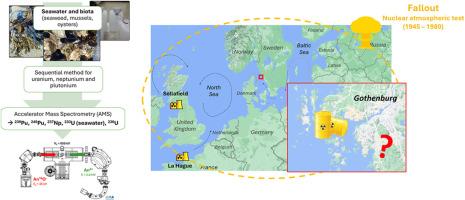当前位置:
X-MOL 学术
›
Environ. Pollut.
›
论文详情
Our official English website, www.x-mol.net, welcomes your
feedback! (Note: you will need to create a separate account there.)
Anthropogenic actinides in seawater and biota from the west coast of Sweden
Environmental Pollution ( IF 7.6 ) Pub Date : 2024-11-10 , DOI: 10.1016/j.envpol.2024.125289 M. López-Lora, E. Chamizo, M. Eriksson
Environmental Pollution ( IF 7.6 ) Pub Date : 2024-11-10 , DOI: 10.1016/j.envpol.2024.125289 M. López-Lora, E. Chamizo, M. Eriksson

|
The assessment of the origin of the anthropogenic contamination in marine regions impacted by other sources than global fallout is a challenge. This is the case of the west coast of Sweden, influenced by the liquid effluents released by the European Nuclear Reprocessing Plants through North Sea currents and by Baltic Sea local and regional sources, among others. This work focused on the study of anthropogenic actinides (236U, 237Np and 239,240Pu) in seawater and biota from a region close to Gothenburg where radioactive wastes with an unknown composition were dumped in 1964. To this aim, a radiochemical procedure for the sequential extraction of U, Np and Pu from biota samples and the subsequent analysis of 236U, 237Np, 239Pu and 240Pu by Accelerator Mass Spectrometry was developed. The method was validated through the study of two reference materials provided by the International Atomic Energy Agency (IAEA): IAEA-446 (Baltic Sea seaweed) and IAEA-437 (Mediterranean Sea mussels). The 233U/236U atom ratio was also studied in the seawater samples. The obtained results indicate that the North Sea currents and global fallout are the major sources for 236U, 237Np and 239,240Pu to the studied area, without clear evidence of other local sources. Complementary, information on the Concentrations Factors (CF) in biota was obtained, for which the available information is very scarce. For seaweed, CF values of (4.07 ± 0.90)·103, 61 ± 22 and 76 ± 16 have been obtained for Pu, Np and U, respectively. Lower CF values of (3.37 ± 0.78)·102, 34 ± 10 and 15.9 ± 3.4 for Pu, Np and U, respectively, have been obtained for mussels.
中文翻译:

瑞典西海岸海水和生物群中的人为锕系元素
评估受全球沉降物以外的其他来源影响的海洋地区人为污染的来源是一项挑战。瑞典西海岸就是这种情况,受到欧洲核后处理厂通过北海洋流以及波罗的海当地和区域来源等排放的液体流出物的影响。这项工作的重点是研究来自哥德堡附近地区的海水和生物群中的人为锕系元素(236U、237Np 和 239,240Pu),1964 年,那里倾倒了成分未知的放射性废物。为此,开发了一种放射化学程序,用于从生物群样品中连续提取 U、Np 和 Pu,然后通过加速器质谱法对 236U、237Np、239Pu 和 240Pu 进行分析。该方法通过研究国际原子能机构(IAEA)提供的两种参考材料得到验证:IAEA-446(波罗的海海藻)和IAEA-437(地中海贻贝)。还研究了海水样品中的 233U/236U 原子比。获得的结果表明,北海洋流和全球沉降物是研究区域 236U、237Np 和 239,240Pu 的主要来源,没有其他当地来源的明确证据。互补地获得了有关生物群中浓度因子 (CF) 的信息,而可用的信息非常稀缺。对于海藻,Pu、Np 和 U 的 CF 值分别为 (4.07 ± 0.90)·103、61 ± 22 和 76 ± 16。较低的 CF 值为 (3.37 ± 0.78)·102、34 ± 10 和 15.9 ± 3。Pu 为 4,贻贝为 Np 和 U。
更新日期:2024-11-10
中文翻译:

瑞典西海岸海水和生物群中的人为锕系元素
评估受全球沉降物以外的其他来源影响的海洋地区人为污染的来源是一项挑战。瑞典西海岸就是这种情况,受到欧洲核后处理厂通过北海洋流以及波罗的海当地和区域来源等排放的液体流出物的影响。这项工作的重点是研究来自哥德堡附近地区的海水和生物群中的人为锕系元素(236U、237Np 和 239,240Pu),1964 年,那里倾倒了成分未知的放射性废物。为此,开发了一种放射化学程序,用于从生物群样品中连续提取 U、Np 和 Pu,然后通过加速器质谱法对 236U、237Np、239Pu 和 240Pu 进行分析。该方法通过研究国际原子能机构(IAEA)提供的两种参考材料得到验证:IAEA-446(波罗的海海藻)和IAEA-437(地中海贻贝)。还研究了海水样品中的 233U/236U 原子比。获得的结果表明,北海洋流和全球沉降物是研究区域 236U、237Np 和 239,240Pu 的主要来源,没有其他当地来源的明确证据。互补地获得了有关生物群中浓度因子 (CF) 的信息,而可用的信息非常稀缺。对于海藻,Pu、Np 和 U 的 CF 值分别为 (4.07 ± 0.90)·103、61 ± 22 和 76 ± 16。较低的 CF 值为 (3.37 ± 0.78)·102、34 ± 10 和 15.9 ± 3。Pu 为 4,贻贝为 Np 和 U。


















































 京公网安备 11010802027423号
京公网安备 11010802027423号